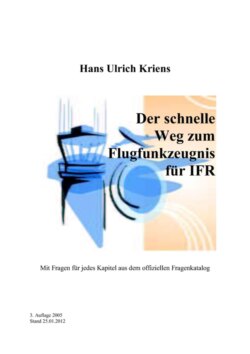Читать книгу Der schnelle Weg zum Flugfunkzeugnis für IFR - Hans Ulrich Kriens - Страница 2
На сайте Литреса книга снята с продажи.
Chapter 1 Abbreviation and definitions Definitions
ОглавлениеAeronautical station A station in the aeronautical mobile service located on land or, in certain instances, on board of a ship or on a platform at sea
Air-ground communication Two-way communication between aircraft and stations or locations on the surface of the earth
Automatic Terminal Information Service The provision of current routine information to arriving and departing aircraft by means of continuous and repetitive broadcast throughout the day or a specific portion of the day
Blind transmission A transmission from one station to another station in circumstances where two-way communication cannot be established but where it is believed that the called station is able to receive the transmission
Broadcast A transmission of information relating to air navigation that is not addressed to a specific station or stations
Broken In meteorological report cloud coverage of 5 to 7 octas will be classified as broken
Clearance limit A point to which an aircraft is granted an air traffic control clearance
Estimated time of arrival The time at which it is estimated that the aircraft will arrive over that designated point defined by reference to navigation aids, from which it is intended, that an instrument approach will be commenced
Expected approach time The time at which ATC expects that an arriving aircraft, following a delay, will leave the holding point to complete its approach for a landing
Flight level A level in the atmosphere for vertical separation which is determined by setting the altimeter to 1013,2 hPa
Overcast When the term "overcast" is used in radio telephony in connection with meteorological conditions clouds are covering 100% of the sky.
Scattered When the term "scattered" is used in radio telephony in connection with meteorological conditions clouds covering half or less then half of the sky
Transition Level The transition level is the lowest usable flight level. At this level the altimeter will be changed from 1013,2 hPa to QNH during descend below the flight level system. It is determined on the basis of transition altitude and QNH and should be at least 1000 ft above the transition altitude. For example: Transition altitude is 5000ft. At an QNH of 1014 or higher the transition level is FL60, QNH is between 1013 and 978 transition level is FL70 and QNH below 977 the transition level will be FL80 The transition level is determined on the basis of transition altitude and QNH
Transition layer The transition layer is the layer between the transition altitude and transition level. The extension of this layer must be at least 1000 ft.
Visual approach An approach by an IFR flight when either part or all of an instrument approach procedure is not completed and the approach is executed in visual reference to terrain
way point A specified geographical position used to define an area navigation route or the flight path of an aircraft employing area navigation
